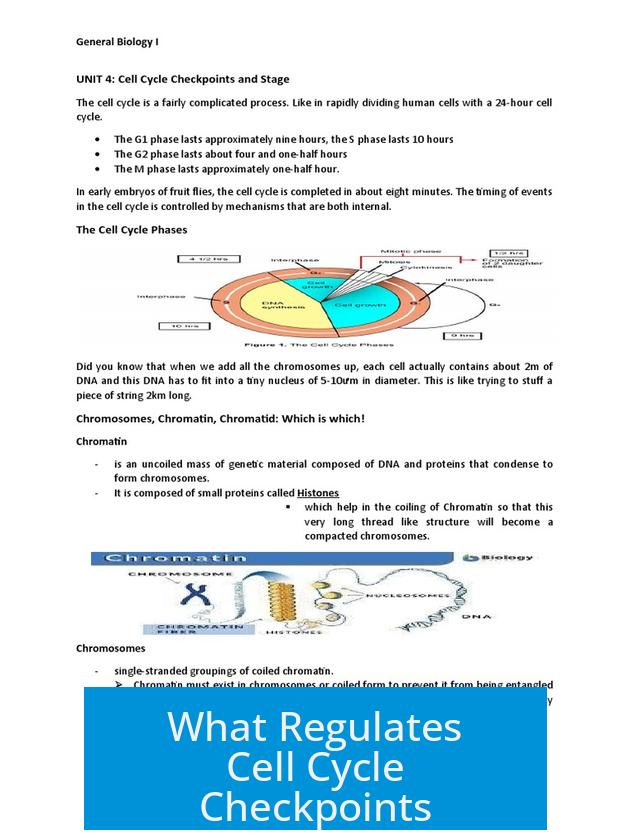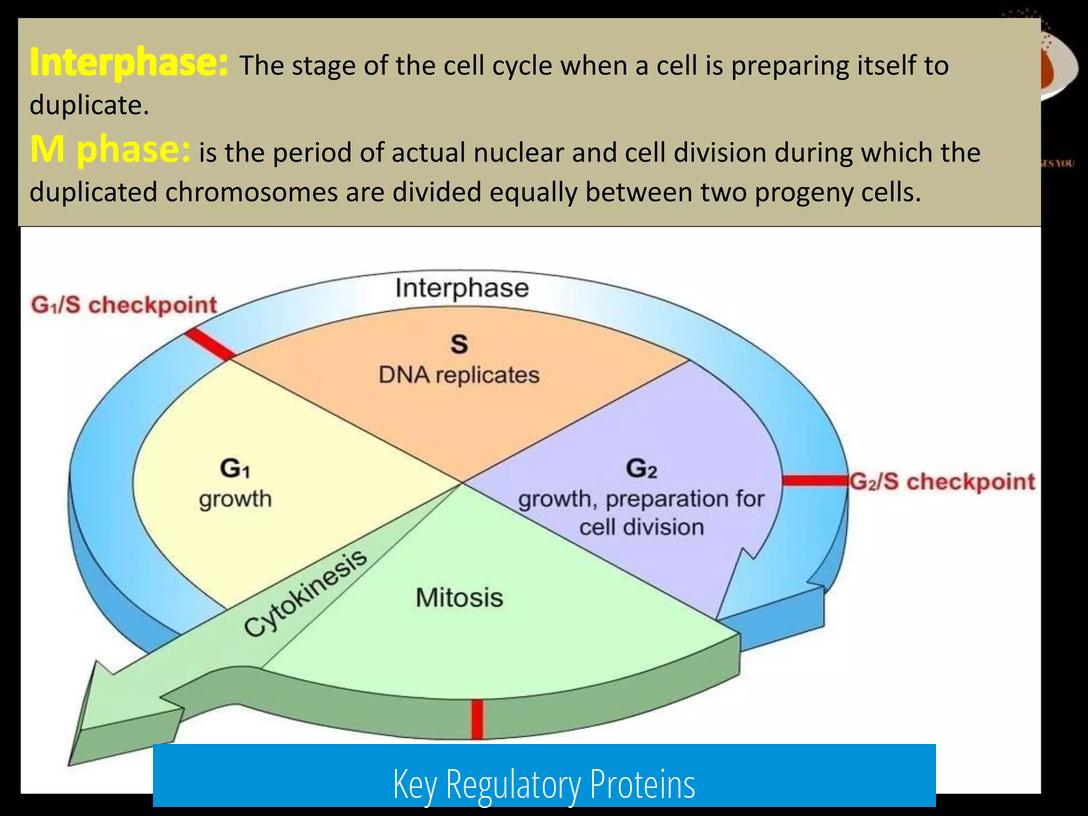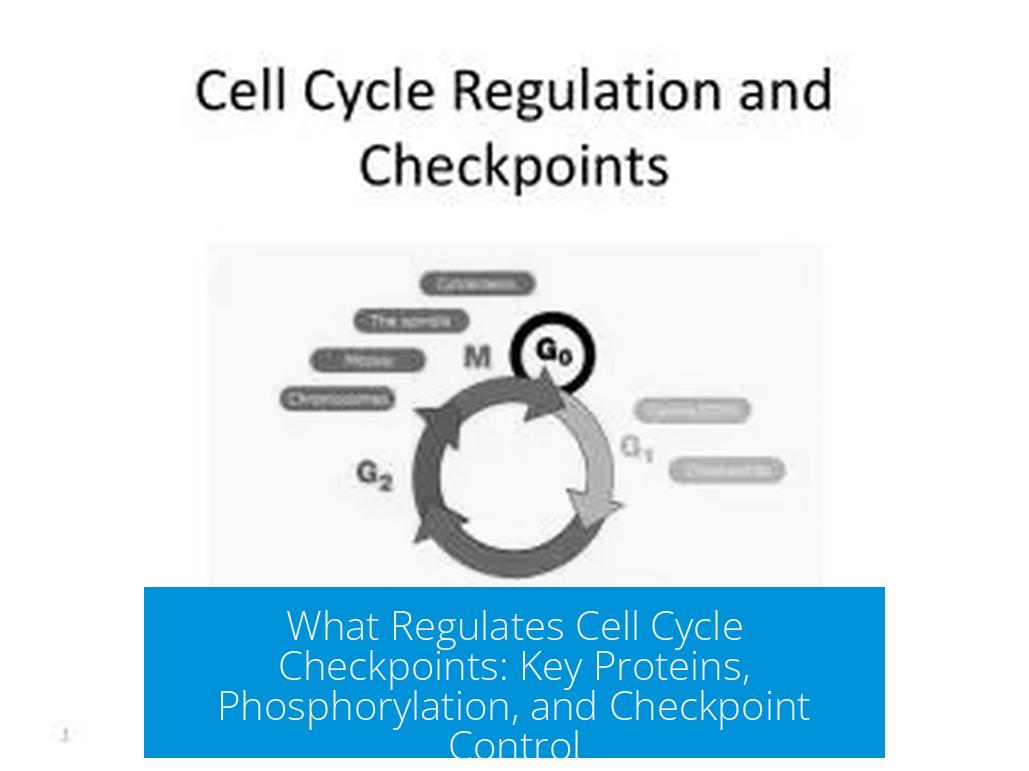What Regulates Cell Cycle Checkpoints?

Cell cycle checkpoints are regulated by a complex network including phosphorylation events, protein degradation, and multiple regulatory proteins such as cyclin/CDKs, p21, and Cdc25. These components work together to ensure proper cell cycle progression and maintain genomic stability.
Phosphorylation and Its Role

Phosphorylation plays a central role in regulating cell cycle checkpoints. It activates Cyclin-dependent kinases (CDKs), which drive the cell cycle forward. Additionally, phosphorylation can mark certain proteins for degradation, which is essential for checkpoint control. CDKs often require phosphorylation to become active and initiate transitions between cycle phases.
Key Regulatory Proteins

- Cyclin/CDKs: The core engine of the cell cycle, these complexes allow the cell to progress by phosphorylating target proteins.
- p21: Acts as an inhibitor by binding to G1 phase CDK/cyclin complexes, providing an additional layer of regulation.
- Cdc25: Functions as an activator of M phase CDK/cyclin complexes, opposing p21’s inhibitory action, and is essential for entering mitosis.
Protein Degradation and Checkpoint Control
Protein degradation is vital in cell cycle checkpoints. The 26S proteasome degrades cyclins and securins to halt mitosis progression when necessary. This degradation ensures that cells do not prematurely enter the next phase. For example, after G2, degradation events coordinate the Spindle Assembly Checkpoint (SAC) between metaphase and anaphase.
Multiple Cell Cycle Checkpoints
Several checkpoints exist during the cell cycle to monitor different processes:
- G1 checkpoint regulating commitment to DNA synthesis
- S phase checkpoints ensuring proper DNA replication
- G2 checkpoint controlling entry into mitosis
- Spindle Assembly Checkpoint (SAC) during metaphase
- Anaphase and telophase checkpoints monitoring chromosome segregation and mitotic exit
This implies the existence of potentially six or more checkpoints, highlighting the complexity of cell cycle regulation.
Summary of Key Points
- Phosphorylation activates CDKs and targets proteins for degradation.
- p21 inhibits G1 CDK/cyclin complexes, regulating early cell cycle stages.
- Cdc25 activates M phase CDK/cyclin complexes, permitting mitosis entry.
- Protein degradation, especially of cyclins and securins, is crucial for checkpoint transitions.
- Multiple checkpoints safeguard different phases, including G1, S, G2, metaphase, anaphase, and telophase.
What Regulates Cell Cycle Checkpoints? Unlocking the Cellular Traffic Lights
In a nutshell, the cell cycle checkpoints get regulated by a finely tuned network of proteins, primarily involving phosphorylation events, cyclin-dependent kinases (CDKs), inhibitors like p21, activators such as Cdc25, and crucially, the controlled degradation of certain proteins.
If you picture the cell cycle as a well-organized highway, checkpoints are the traffic lights ensuring that everything moves safely and on time. But who controls these signals? Let’s dive into this fascinating biochemical symphony that keeps our cells in check.
Phosphorylation: The Molecular Switchboard
At the heart of cell cycle regulation lies phosphorylation. Think of phosphorylation as adding a tiny chemical “post-it note” to proteins that drastically alters their functions. Many molecules governing cell cycle checkpoints rely on this modification.
For instance, CDKs, essential enzymes driving cell cycle progression, require phosphorylation to shift from ‘off’ to ‘on’. This activation allows them to form complexes with cyclins—special regulatory proteins. But that’s not all; phosphorylation also tags certain proteins for destruction, ensuring timely removal from the scene.
More Than One Control Knob: The Complex Regulation
It’s tempting to credit a single player like the cyclin/CDK duo as the master regulator. Reality laughs and whispers, “Not so fast!” In truth, cell cycle regulation mimics a layered control system. Various molecules collaborate intricately to keep the process flawlessly timed.
For instance, along with cyclin/CDKs, proteins like p21 and Cdc25 join the regulatory party. P21 functions as a watchdog during the G1 phase, while Cdc25 gears up the machinery for mitosis. Together, they form a balanced network, ensuring cells don’t prematurely or improperly divide.
The Specific Regulators: A Trio of Characters
- P21: The G1 Gatekeeper This protein acts as an extra layer of control early in the cycle. P21 binding to the G1 cyclin/CDK complex essentially says, “Hold on, not yet.” It ensures DNA is ready and conditions favorable before the cell commits to division.
- Cdc25: The M Phase Starter Unlike p21 which halts progression, Cdc25 has the green light baton. It activates the cyclin/CDK complexes needed to enter mitosis by removing inhibitory phosphates. The result? Cells can progress smoothly into mitosis.
- Cyclin/CDKs: The Core Drivers This dynamic duo is the engine of cell cycle progression. CDKs are mostly inactive alone but become powerful kinases once bound to cyclins and phosphorylated. Each phase has specific cyclin/CDK pairs regulating transitions.
Protein Degradation: Cleaning Up to Move Forward
What if the cell tried to move on with old instructions? Disaster. Luckily, cells avoid this by destroying regulatory proteins at precise moments.
Mitotic progression halts until cyclins and securins get tagged for destruction by the 26S proteasome, the cell’s recycling center. This prevents premature progression into anaphase, ensuring chromosomes are properly aligned and attached to the spindle apparatus.
One key checkpoint here is the Spindle Assembly Checkpoint (SAC), situated between metaphase and anaphase. It acts as a final security check, verifying that all chromosomes are correctly connected before allowing the cell cycle to continue.
How Many Checkpoints Are There Really?
Most textbooks mention the familiar G1, G2, and M phase checkpoints. But newer studies hint at additional control points during S phase, anaphase, and even telophase. Could there be six checkpoints rather than three? The answer is: possibly.
This multiplicity of checkpoints underscores just how important tight control is. Each checkpoint is like a ‘quality control inspector’ ensuring the genome remains intact and damage-free before the cell divides.
Putting It All Together: Why Should You Care?
Why does understanding cell cycle checkpoints matter? Well, these regulators are gatekeepers against cancer. Faulty regulatory proteins can lead to uncontrolled division—classic tumor territory.
Knowing that phosphorylation toggles enzyme activity and directs protein degradation aids in designing targeted therapies. For example, drugs that inhibit cyclin/CDK activity or boost p21 function have shown promise in cancer treatment research.
Plus, understanding checkpoints also impacts regenerative medicine, where controlled cell division is vital. Scientists can manipulate these pathways to grow tissues efficiently without risking abnormal growth.
Real-World Analogy and a Thought to Ponder
Imagine your local traffic system managed by just one signal controlling your entire city’s traffic. Chaos, right? Instead, multiple systems work together—timers, sensors, priority vehicles—to keep things flowing smoothly.
Similarly, the cell cycle depends on a network: phosphorylation cues, active and inhibitory proteins, and timely destruction all coordinate to keep the cell’s journey safe.
Next time you hear “cell division,” remember it’s like managing an intricate city wide traffic system, governed by biochemical signals and molecular regulators ensuring everything ticks on time.
Final Tips for the Curious Mind
- If you’re studying cell biology, always remember phosphorylation and protein degradation are key themes in regulation.
- When considering cancer or cell-related diseases, think about how these checkpoints might fail or become hijacked.
- Use animations or models to visualize how cyclin/CDKs, p21, and Cdc25 interact during the cycle phases. It helps cement understanding beyond dry facts.
Cell cycle checkpoints are a tale of teamwork, where molecules pass signals, modify each other, and decide a cell’s fate. They remind us that in biology, as in life, timing is everything.
What key molecules regulate cell cycle checkpoints?
Cell cycle checkpoints are regulated by a group of molecules including cyclin/CDKs, p21, and Cdc25. These proteins work together to control progression at different phases of the cycle.
How does phosphorylation influence cell cycle checkpoints?
Phosphorylation activates cyclin-dependent kinases (CDKs), essential for checkpoint control. It also marks certain proteins for degradation, allowing orderly cell progression.
What role does p21 play in checkpoint regulation?
p21 inhibits the G1 cyclin/CDK complex, adding a layer of control. By binding to this complex, it can halt the cycle if conditions are not favorable for cell division.
How does Cdc25 affect cell cycle checkpoints differently than p21?
Cdc25 activates cyclin/CDK complexes during M phase, unlike p21 which inhibits them. This activation triggers progression through mitosis.
What is the significance of protein degradation in checkpoint control?
Degradation of cyclins and securins by the 26S proteasome is crucial to halt mitosis until conditions are right. This process ensures correct chromosome separation and timing.
Where are the main checkpoints located in the cell cycle?
Major checkpoints include G1/S, G2/M, and the Spindle Assembly Checkpoint (SAC) between metaphase and anaphase. Other checkpoints may exist in S phase, anaphase, and telophase.





Leave a Comment